Hypertension
Hypertension : Definition
Western Medicine
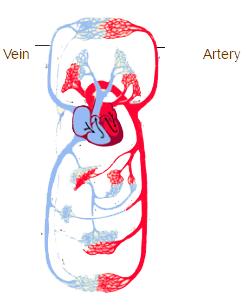
Hypertension is known as abnormally high blood pressure in the arteries. When your heart beats, it pumps blood to the arteries and creates pressure in them. Blood pressure is responsible for delivering oxygen to your organs, because without oxygen the organs would not work. Blood pressure rises as a normal response to stress and physical activity. However, people with hypertension have high blood pressure even when they are not undergoing a lot of physical activity. Normal blood pressure is usually less than 140/90 mm Hg, defined as millimeters of mercury, for an adult. Blood pressure that overs this level is considered high. Your healthcare provider may take several readings before making a decision about whether your blood pressure is considered to be in the high range.
Hypertension increases your risk for developing vascular and heart diseases, which may lead to a heart attack or stroke.
High Blood Pressure Facts and Myths
Chinese Medicine
According to Traditional Chinese Medicine (TCM), there is no term or definition that specifically refers to the modern definition of hypertension. The disease is understood in TCM by the common symptoms like headache, dizziness and light headedness, which come under disharmony categories such as "dizziness" and "headache." Some specific types of hypertension are also related with disharmony categories, such as "coma" and "convulsion," that occur in hypertensive brain disease as well as "pre-eclampsia", a severe hypertension during pregnancy.
In ancient China, because of no effective medications in controlling hypertension, it led to the development of many secondary diseases, such as stroke, one of the four major disharmony categories in TCM, often develops from hypertension. Other complications include chest pain, cardiac asthma (asthma caused by heart disease), and edema (swelling).
Information about hypertension diagnosis and treatment is scattered in a variety of TCM classics. The early descriptions can be found in The Plain Questions, which has the following to say about a hypertension related symptom: "dizziness caused by wind evil is related to liver disorder." Also, the book states: "head problems such as headache, dizziness and boils are closely associated with weakened liver and kidney that lead to yin deficiency in the lower body and yang hyperactivity in the upper body." Thereafter, many TCM physicians mentioned the experiences in their books. For example, the book entitled Secret Storage of Orchid Chamberreads: "dizziness and blurred vision are caused by wind evil inside the body, and should be treated with the herb named Rhizoma Gastrodiae." Another book Guiding Cases for Clinical Treatment states: "people with dizziness will soon develop stroke," and "the cause of it is mainly originated from liver disorder."
The above old records are the important references for modern TCM to manage hypertension.
Hypertension : Causes
Western Medicine
When there is no obvious cause for high blood pressure, it is called essential or primary hypertension, which makes up 95 per cent of all hypertension cases. The second kind of hypertension is known as secondary hypertension and makes up about 5 per cent of hypertension cases.
Symptoms of secondary hypertension may include elevated blood pressure due to disorders of the kidney, adrenal glands (glands that sit on top of the kidney and secrete hormones), aorta (the main artery of the body) or narrowing of certain arteries.
High blood pressure can occur in children or adults, but is more common in people over the age of 35. It is also more prevalent in elderly and in people who have a family history of hypertension. People with diabetes, gout or kidney disease also have a higher risk for hypertension. Lifestyle habits such as smoking, excessive drinking of alcohol and obesity or eating too many sweets and foods high in fat may increase your risk for high blood pressure.
Chinese Medicine
From a TCM view, hypertension development is a complex and chronic process. It is due to a combined effect of emotional stimulations, internal injuries, improper diet and constitutional factor. The factors disturb qi (vital energy) and blood activities, and weaken the body’s regulatory functions. Internally, liver and kidney systems are usually affected, while formation of internal pathogens (evils) such as wind, fire, phlegm and blood stasis can give rise to a variety of disharmony patterns.
As mentioned in the definition section, hypertension is understood in TCM by its symptoms such as "dizziness" and "headache;" the pathology is interpreted as below:
1. Hyperactivity of liver-yang
The liver dominates the conducting and dispersing of qi movement; liver-yang has the property of upward motion and causes qi or body fluids to ascend, while liver-yin has the property of static motion and causes qi, blood and body fluids to descend. The two aspects mutually restrict and promote each other in order to maintain balance in the body. Hyperactivity of liver-yang triggers qi and blood to ascend, and the acceleration of qi movement produces wind evils, that can lead to symptoms of dizziness, tremors or sudden blackout. Hyperactivity of liver-yang happens when:
- The body develops a tendency to excess yang.
- Emotional disturbances such as depression, anger, tension and excessive thinking occur, which induce stagnation of liver-qi, and the stagnated qi will transform into fire evil to impair yin.
- Chronic deficiency of kidney-yin occurs. This means the element water (kidney organ) fails to nourish the wood element (liver organ), which results in hyperactivity of liver-yang.
2. Liver-wind and turbid phlegm attack upwards
When the body is in a state of liver-yang hyperactivity, internal wind and phlegm can easily be generated. The evils disturb the meridian activities and affect qi and blood flowing to the brain. This can result in unconsciousness or numbness of limbs that are serious symptoms of hypertension. Factors disturb body fluid redistribution and induce phlegm accumulation are:
- Over consumption of greasy food and drink that leads to spleen malfunction.
- A busy and stressful lifestyle damages spleen-yang that affects the body fluids transformation and transportation.
- Lung weakness that fails to promote fluids distributing throughout the body, and facilitates the accumulated body fluids to transform into phlegm.
- Kidney weakness that causes excessive fluid to build up in the body and transforms into phlegm.
3. Imbalance of yin and yang
In TCM, kidney is regarded as the center of the body's yin and yang, the "congenital foundation," or the origin of life. When people get older, essence stored in the kidney becomes depleted, and imbalance of yin and yang will result. Yin deficiency tends to occur in the lower body, yang hyperactivity tends to occurs in the upper body, and that result in health problems. For example, virtual fire flares up in the upper body and causes hypertensive symptoms.
4. Other related causes
Although other causes of hypertension are still under investigation, researchers have found the following factors do contribute to the development of high blood pressure:
- heredity
- high salt intake
- highly stressful and intensive occupations
- lack of physical activities
- obesity
- smoking
- heavy consumption of alcohol
- lack of some nutritional ingredients such as unsaturated fatty acid and vitamin C.
- Recent findings show that lots of hypertension sufferers are insulin resistant, meaning they are not sensitive to insulin inside the body or suffer from hyperinsulinemia (high blood level of insulin).
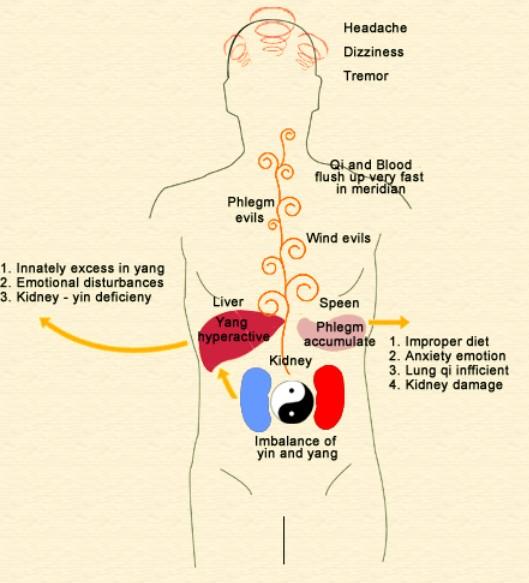 Hypertension development from a TCM perspective
Hypertension development from a TCM perspective
Hypertension : Symptoms
Western Medicine
People who suffer from hypertension typically feel fine and look healthy. The disease does not typically produce any symptoms, and it is usually discovered by the physician during a routine physical exam. However, high blood pressure increases the workload of your heart and arteries. The heart must pump harder because the arteries that carry blood to the organs are under great pressure. If hypertension is left uncontrolled, high blood pressure can lead to other problems such as a heart attack or a stroke, and the increased risk of developing heart failure or kidney disease. It can also damage the retina at the back of the eyes. (Retina is the fragile light-sensitive internal coating of the eyeball that is full of small blood vessels.)
The only way to know if you have high blood pressure is to get your blood pressure measured by your physician.
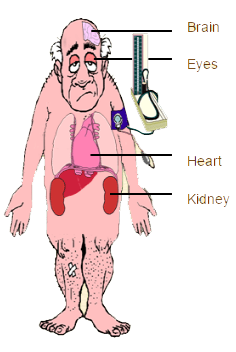
Complications of hypertension
Chinese Medicine
The clinical features of hypertension are non-specific, only occasional dizziness and headache. However, TCM believes that individuals can accompany signs that are associated with particular disharmony patterns. For example, when individuals belong to a yang pattern, they may have heat-manifested signs such as flushed face, bitter taste in mouth, irritability, yellowish urine, or constipation. Since these clinical features are usually mild and not obvious, most individuals would neglect and not report to their physicians.
Hypertension is most often diagnosed during a routine medical examination or a special screening program. When TCM physician diagnoses the disharmony patterns associated with hypertension, it usually means it has progressed to a stage where complications or organ damages have already occurred.
Below are some disharmony patterns of hypertension.
1. Hyperactivity of liver-yang
High blood pressure, other accompanied symptoms include dizziness, ringing in the ears, distending headache (forehead particularly), irritability, insomnia and fitful sleep. In some cases, there may have flushed face, bitter taste in the mouth, blood-shot eyes, constipation and yellowish urine. The tongue is red and covered with yellow fur. The pulse is taut and rapid. In severe cases, individuals will experience nausea, severe headache, slurred speech, numb and shaking limbs that result in instability while walking.
2. Yin deficiency and yang hyperactivity
High blood pressure, other accompanied symptoms include lower back soreness, knee weakness, poor memory, and seminal emission. The tongue appears thin and tender, and is covered with little or no fur. The pulse is taut and thready or rapid. In severe cases, individuals may have headaches, flushed cheeks, throat dryness, skinny, irritability, and hot sensation in the chest, palms and soles.
3. Deficiency of both yin and yang
High blood pressure, other accompanied symptoms include low spirit, dizziness, blurred vision, palpitations, breath shortness while moving, limb coldness, lower back soreness, lower limb weakness, puffiness, night frequency, sex dysfunction, poor sleep or dream-disturbed sleep. The tongue is pale, and the pulse is taut, thready and forceless.
4. Liver-wind and turbid phlegm
High blood pressure, other accompanied symptoms include dizziness, fatigue, distending and heaviness sensations in the head, chest stuffiness, spitting of thick saliva, ringing in the ears, and blurred vision. In severe cases, individuals may experience limb numbness, sudden distortion of the face (facial paralysis), difficulty in speech, drooling and even paralysis of one side of body. The tongue is covered by greasy fur, and the pulse is taut and rolling.
5. Blood stasis blocking collaterals
High blood pressure, other accompanied symptoms include dizziness, stabbing pain in the head, palpitations, poor memory, spiritual fatigue, chest stuffiness or pain, limb numbness, dark-purplish complexion or lips, purplish tongue or purple spots on it, and the pulse is taut and hesitant, or knotted.
Generally, hypertension symptoms can vary from person to person, and the degree of severity may not coincide with the clinical stages.
Hypertension : Diagnosis
Western Medicine
To minimize the fluctuation of blood pressure caused by negative influences such as stress and environment, the diagnosis of high blood pressure usually requires at least two measurements at two different times after the first initial screening.
Before the screening, those being tested should relax and should not consume coffee or any drink that contains caffeine before the measurement. Caffeine can transiently elevate your blood pressure, although there is no evidence that suggests caffeine contributes to long-term hypertension. Smokers should refrain from smoking before their blood pressure is measured. 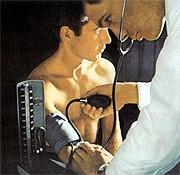
Blood pressure is measured with an instrument called a sphygmomanometer and is counted in millimeters of mercury (mm Hg). A rubber cuff is wrapped around the upper arm and then inflated. This compresses a large artery in the arm, momentarily stopping the blood flow. The air in the cuff is then released and the health care provider measuring the blood pressure listens with a stethoscope. When the blood pressure starts to pulse through the artery, it makes a sound. While the physician listens and watches the gauge, two measurements are recorded. The first number is the systolic pressure, which is the amount of pressure in your arteries when your heart is pumping or the pressure when the first sound is heard. The second number, known as diastolic pressure, is the amount of pressure when your heart is resting between beats and the pressure when the last sound is heard. As follows with medical custom, the systolic pressure is always reported first and the diastolic pressure second.
Hypertension is defined as systolic blood pressure (SBP) of 140 mm Hg or greater, diastolic blood pressure (DBP) of 90 mm Hg or greater. Normal blood pressure is equal or below 120/80 mm Hg.
Hypertension is further classified into different stages. These stages, along with other risk factors, help determine the degree and type of treatment. Table 1 shows the classification of blood pressure in adults over 18 years of age not currently taking any medications for high blood pressure.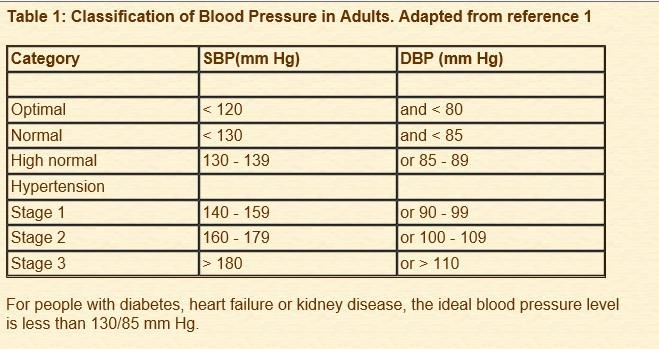
Chinese Medicine
Hypertension is largely diagnosed by abnormal readings of blood pressure that measured on three separate occasions. (Please see above western medicine section for reference). 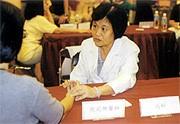
Based on the four examination skills, TCM practitioners will diagnose hypertension according to its clinical symptoms and further specify it by the disharmony patterns displayed by individuals. As TCM believes that at various stages of a disease, specific disharmony patterns are present which require different types of therapy. That is why two individuals with the same disease may be treated very differently by their TCM practitioners. Common disharmony patterns of hypertension are:
1. Hyperactivity of liver-yang
Main features: distending pain in the head, dizziness, blurred vision, irritability, poor sleep, flushed face, bitter taste in mouth, a red tongue with thin yellow coating, and the pulse is taut and forceful. There may also accompany rib-side discomfort.
Analysis: liver hyperactivity means the organ can’t play its regulatory role properly and thus results in the distending headache, dizziness and blurred vision; liver fire irritates the spirit that results in the irritability and poor sleep; while the rib-side discomfort, flushed face and bitter taste are caused by fire transformed from stagnated qi in the liver and gallbladder. Other signs like the red tongue with thin yellow coating, taut and forceful pulse are the indications of liver-yang hyperactivity. This pattern usually occurs in the early stage of hypertension.
2. Yin deficiency of liver and kidney
Main features: dull pain in the head, dizziness, blurred vision, buzzing of the ears, hot sensation in the chest, palms and soles, lumber soreness and lower leg weakness. The tongue is red with little fur, and the pulse is thready or thready and rapid.
Analysis: yin deficiency results in relatively yang hyperactivity, when this affects the head region, there will be dull pain in the head, blurred vision and dizziness; yin deficiency tends to generate virtual fire, and thus results in the hot sensations; kidney is housed in the lumbar and it also dominates the bones, so the lumbar soreness and lower leg weakness are related to kidney weakness; other signs like the red tongue with little fur, and thready pulse are coincided with yin deficiency of liver and kidney, the rapid pulse means the internal body is heated. This pattern usually occurs in the middle stage of hypertension.
3. Deficiency of both yin and yang
Main features: dizziness, poor memory, skinny, mouth dryness, hot sensation in the chest, palms and soles, general weakness, spiritual fatigue, breath shortness, night frequency, lumbar soreness, and knee weakness. The tongue is pale, and the pulse is thready and forceless.
Analysis: kidney essence is an important component of body’s yin, and due to its depletion, the whole body is under-nourished. The brain can’t function normally, and thus develops the dizziness and poor memory; the muscles are wasting and thus becomes skinny; insufficiency of fluid production and thus has the mouth dryness; yin deficiency creates virtual fire, and thus has the hot sensations. On the other hand, yin deficiency leads to a gradual depletion in body’s yang, and so has the spiritual fatigue and breath shortness; while night frequency, lumbar soreness and knee weakness are the indications of kidney deficiency; other signs like the pale tongue, thready and forceless pulse are coincided with yin and yang deficiency. This pattern usually occurs in the late stage of hypertension that has last for a long time. Individuals are mostly older, have persistent high blood pressure and with complications in the heart, brain or kidney organs.
4. Phlegm and dampness accumulation
Main features: distending and heaviness sensations in the head, dizziness, chest stuffiness, nausea, poor appetite, sleepiness, greasy tongue coating and taut and rolling pulse.
Analysis: the head orifices are obstructed by the excess dampness and phlegm, and thus cause the distending headaches, dizziness and sleepiness; phlegm and dampness accumulation is often associated with dysfunction of the middle burner, so there is chest stuffiness and nausea; since spleen and stomach are located in the middle burner, and so affected the appetite; the white greasy tongue coating, and taut and rolling pulse are the indications of excess phlegm and dampness. This type of individuals is often obese, not physically active, and they tend to have inefficient digestion and absorption, or a poor appetite.
5. Blood stasis blocking collaterals
Main features: dizziness, stabbing pain in the head or chest, chest stuffiness, limb numbness, purplish tongue and lips, or purple spots on the tongue, thready or hesitant pulse.
Analysis: persistent high blood pressure tends to develop blood stasis and impede blood flow, which cause the dizziness, stabbing pain in the head or chest, chest stuffiness and limb numbness; the purplish lips, tongue and pulse signs all indicate that blood stasis has developed. This pattern usually occurs in the late stage of hypertension that accompanies organ damages.
6. Asymptomatic hypertension
Hypertensive individuals feel fine and have not symptom. During examination, the tongue may be red or pale red color, the pulse is taut and thready or taut and rolling.
Individuals should be differentiated from conditions where the hypertension is caused by a specific disease process, secondary hypertension is more frequently seen in:
- Individuals with clinical or biochemical features of a specific disorder. For example, abnormal blood hormone levels, such as catecholamines might suggest an endocrine disease of pheochromocytoma.
- Young age (30-years-old and under)
- Accelerated hypertension (severe cases of hypertension) suggests cardiovascular causes like aneurysm.
- Troublesome hypertension (hypertension that does not respond to medication) suggests renal causes like congenital polycystic kidneys.
Note: If a TCM practitioner suspects there might be a serious problem that Chinese medicine alone cannot treat, he or she will recommend the individual to see a western doctor for further follow up.
Hypertension : Treatment
Western Medicine
1. Lifestyle Modification
Lifestyle modification is important for prevention of hypertension and can be used as treatment for people with high normal blood pressure or people with stage 1 hypertension who have a low risk for heart disease. Lifestyle changes include weight reduction; if the person is overweight, alcohol intake should be limited to no more than 720 ml of beer, 300 ml of wine, or 60 ml of 100 proof whisky per day. For women and people without a weight problem the numbers should be halved. In addition, regular aerobic physical activity such as walking briskly for 30 to 45 minutes several times a week helps reduce blood pressure. Limiting sodium or table salt to 2.4 grams per days can also help reduce blood pressure.
Cigarette smoking increases the risk for cardiac disease. Blood pressure rises with each cigarette that is smoked. Quitting smoking can significantly reduce blood pressure. Having healthy eating habits can reduce your risk for heart disease, and if you need to be on medication, eating a well-balanced diet will help keep your medication dose low.
2. Blood pressure goals
Lifestyle modification should be attempted for at least 6 to 12 months. After that, drug therapy with medications may be initiated if goals are not met. In some cases, medications may be initiated first, and depending upon how high the blood pressure is, additional risk factors for cardiovascular disease and the presence of other organ damage. For example, the target blood pressure level for people with diabetes is 130/80 mm Hg.
3. Self-measurement of blood pressure
Measuring your own blood pressure at home could give an accurate blood pressure reading as some people become very anxious when they visit the health care professional and their blood pressure is elevated because of the stress. This is known as "white coat hypertension." If you are on medication, measuring your own blood pressure can help determine your response to the medication. This will let you know whether your dose is appropriate or if it needs adjustment. Although the sphygmomanometer is the most reliable method for measuring blood pressure, there are many personal home monitors that make measuring blood pressure convenient . It is important to follow the manufacturer's instructions for optimal results. The blood pressure cuff should be of appropriate size and the batteries should be checked frequently. Although home monitors can be of valuable assistance, it is still most important to see your physician for appropriate follow-up.
4. Drug Therapy
Controlling blood pressure with medications clearly decreases your risk of heart disease, kidney disease and stroke. Many kinds of medication are available now, and most of these agents can be taken once a day to help control blood pressure. Initially, the drug should be started at the lowest dose possible to help prevent adverse effects such as too abrupt a reduction in blood pressure. Adjustments are usually made every one to two months depending upon tolerability and response because there are certain side effects that occur quickly and can be serious. It is important to remember to take your medication at the same time each day because this minimizes the fluctuation of blood pressure. There are times, however, when one or more agents must be used to control your blood pressure. Some of these agents have undesirable side effects. Be sure to tell your doctor if any side effects occur because he or she may be able to choose another medication for you. It is important to take medication consistently even if you are feeling well.
Medication types for hypertension
|
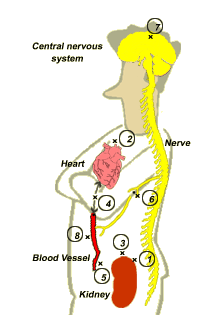 |
Hypertension Treatment Facts and Myths
Chinese Medicine
TCM Treatment of hypertension tends to focus on the overall body rather than the blood pressure alone, the remedies are tailored according the disharmony pattern each individual has. Below are some example prescriptions that used in treating common disharmony patterns associated with this disease.
1. Hyperactivity of liver-yang
Therapeutic aim: Soothe the hyperactive liver, clear fire and extinguish wind
Sample prescription: Gastrodia and Uncaria Decoction
2. Yin deficiency and yang hyperactivity
Therapeutic aim: Nourish yin and check yang
Sample prescription: Calming Liver and Extinguishing Wind Decoction
3. Deficiency of both yin and yang
Therapeutic aim: Warm up kidney-yang, nourish kidney-yin, clear kidney fire, regulate Thoroughfare and Conception Vessels
Sample prescription: Promoting Yin and Yang Decoction
4. Liver wind and turbid phlegm
Therapeutic aim: Resolve phlegm, extinguish wind and unblock collaterals
Sample prescription: Modified Dispelling Phlegm Decoction plus Restoring Facial Distortion Powder
5. Blood stasis blocking collaterals
Therapeutic aim: Activate blood and resolve stasis
Sample prescription: Modified Blood House Stasis Dispelling Decoction
6. Asymptomatic hypertension
Therapeutic aim: Invigorate kidney, nourish liver and lower blood pressure
Sample prescription: Six-ingredient Rehmannia Pill plus rehmannia root, eucommia bark, gambir vine stem, white peony root, red sage root, chrysanthemum and liquorice root.
Individuals should note that hypertension is a chronic and even lifelong condition, therefore long term and regular treatment is necessary, so as to keep the blood pressure in a healthy level, prevent the symptom occurrences and reduce the risk of organ damages.
Hypertension : Prevention
Western Medicine
The best way to prevent hypertension is to live a healthy lifestyle. Researchers are not certain what the exact causes of hypertension are, so it's hard to pin point how to prevent it. However, there are several risk factors that may contribute to hypertension, and put you more at risk for heart disease and stroke. Some prevention strategies for the risk factors include:
- Maintain an optimal body weight. People who are obese with a body mass index (weight in kilograms divided in height in meters squared) of 27 or higher are more likely to have hypertension.
- Reduce salt intake in your diet. Eating too much salt can increase blood pressure in some people.
- Drink alcohol in moderation. Heavy and regular consumption of alcohol can increase blood pressure.
- Exercise regularly. Lack of exercise and inactivity can lead to excess body weight and increase the chances of high blood pressure.
- Avoid tobacco use. Cigarette smoking is a powerful risk factor for heart disease.
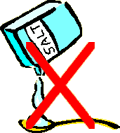 |
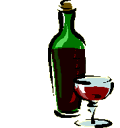 |
 |
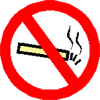 |
Chinese Medicine
As high blood pressure is often due to a combined effect of long term emotional stimulations, internal injuries and improper diet, some active measures can help reduce the chance of developing it, such as healthy diet, regular exercise, controlling body weight, reducing stress, no smoking, moderate drinking and appropriate medical prescriptions.
1. Exercise regularly
Life relies on motion and health depends on exercise. It has been proven that regular exercise and training lead to a stronger body which helps to resist negative influences.
2. A balanced lifestyle
The Chinese medicine approach to healthcare is no different from the general philosophy of western approaches. It considers that appropriate exercise, diet, relaxation, social relationships, and habits all play a part in promoting a healthy body. Where the Chinese model may differ in the area of what is considered "appropriate." It emphasizes the importance of dynamic balance in everything we do, and might lead to approaches that do not favor our lifestyles. Balance and the "middle way" are everything, and although little is ever completely ruled out, nothing is ever considered very dominant.
3. Peace of mind and optimism
TCM believes a person's mindset contains the power to influence the body's functions positively or negatively; positive thinking and an optimistic outlook on life can definitely help maintain a healthy balance in the body.
4. Use herbs for medical prevention
Herbs that have been time tested by TCM practitioners and medically researched can be beneficial in maintaining a healthy balance in the body and preventing chronic diseases such as hypertension. It is important to understand which herbs are fit for your particular condition, and so consult a qualified TCM practitioner for follow up.
 |
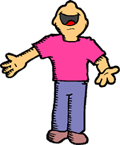 |
 |
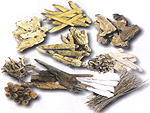 |
Read Hypertension Management
Hypertension : References
Western Medicine References
- The Sixth Report of the National Committee on Prevention, Detection, Evaluation and Treatment of High Blood Pressure. NIH Publication No. 98-4080, November 1997.
- Abramowicz, M., Editor, Drugs for Hypertension, The Medical Letter on Drugs and Therapeutics. Vol. 43 (Issue 1099), March 5, 2001.
- American Heart Association: high blood pressure section.
- National High Blood Pressure Education Program (NHBPEP).
Written By
Frances S. Wong, Pharm.D., CGP, FCSHP
Assistant Professor of Clinical Pharmacy of University at Southern California's School of Pharmacy
Chinese Medicine References
- Beijing University of Traditional Chinese Medicine (edited), Traditional Chinese Internal Medicine, Academy Press, 2000.
- Li En (editor-in-chief), Integrated Clinical Encyclopedia of Traditional and Western Medicine (Vol. 1), Ancient Books Publishing House, 1999.
- Zhang Dazhao (edited), Diagnosis & Treatment of Common Diseases in TCM, WuXiaolong-Hai Feng Publishing Co., 1992.
- Beijing University of Traditional Chinese Medicine (edited), Basic Theories of Traditional Chinese Medicine, Academy Press 2000.
- Davidson's Principles and Practice of Medicine 18th Edition by Churchill Livingstone, 1999.
- Ou Ming (edited), Chinese-English Dictionary of Traditional Chinese Medicine, Joint Publishing (HK) Co. Ltd., 1999.
Written By
Ms. Jiang Mei Xian (蔣梅先女士)
Head of the Department of Coronary Medicine at Shu Guang Hospital in Shanghai
Teaching Supervisor in the Traditional Chinese Medicine (TCM) Department at Shanghai University
Deputy Chief of the Teaching and Research Section of International Medicine at Shu Guang Clinical Medicine College, affiliated with Shanghai University of TCM
Member of the Specialized Committee of Heart Diseases under the Shanghai Traditional Chinese Medicine Association
Translations
Michael Yang, Integrated Chinese Medicine Holdings Ltd.
Editors
Angela Collingwood, MSN Integrated Chinese Medicine Holdings Ltd.
Rose Tse, Integrated Chinese Medicine Holdings Ltd.
Amy Wu, Integrated Chinese Medicine Holdings Ltd.


